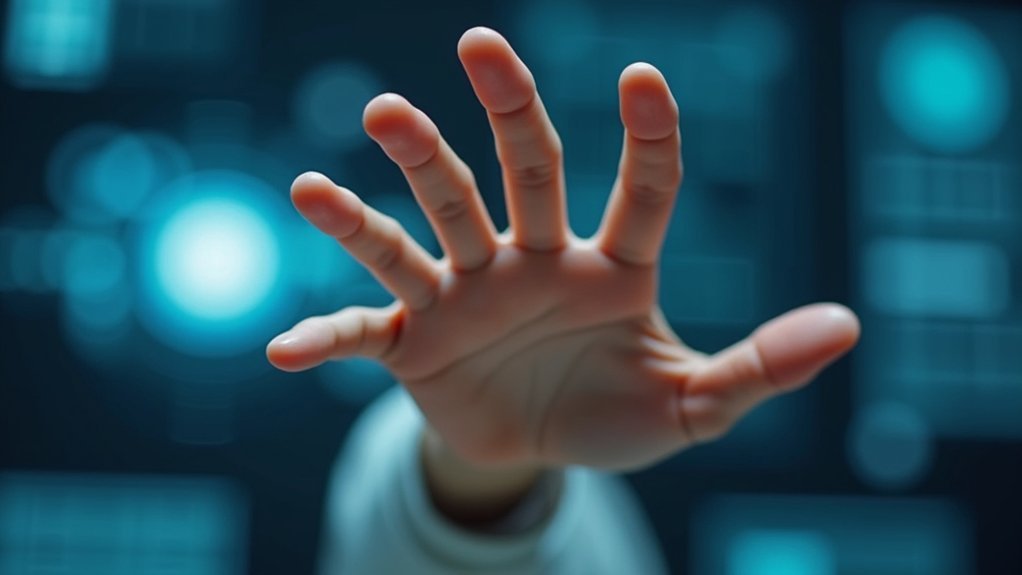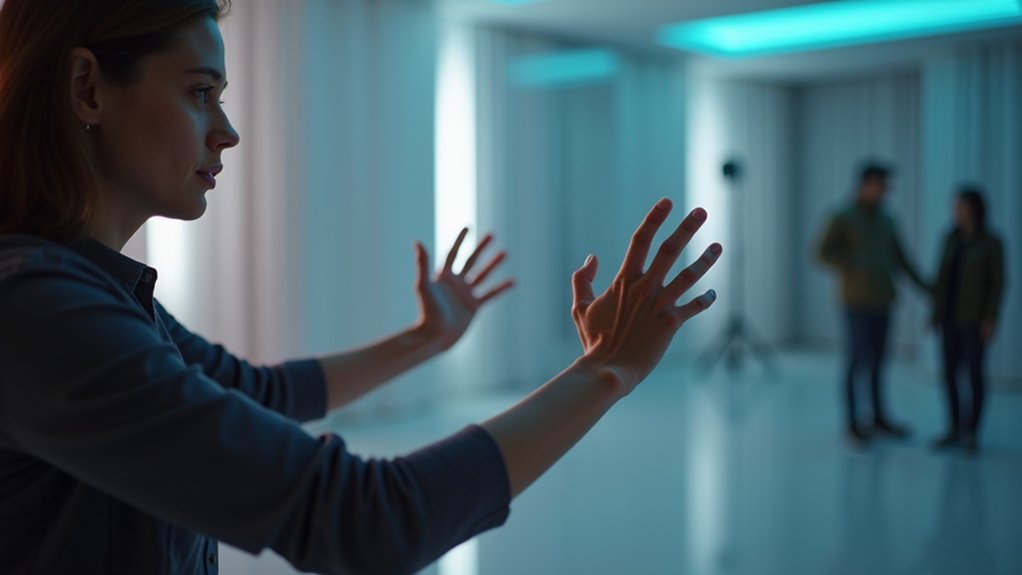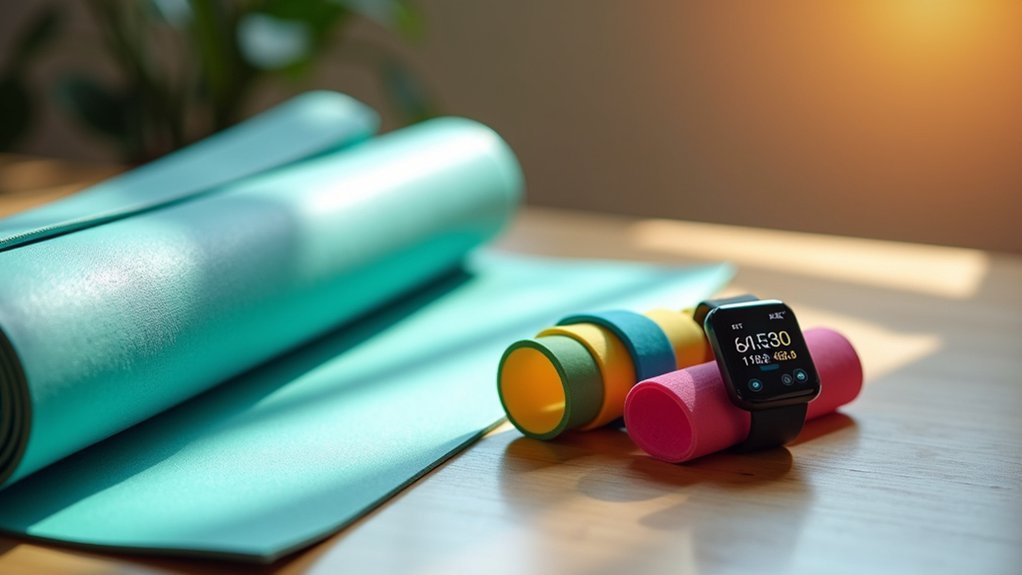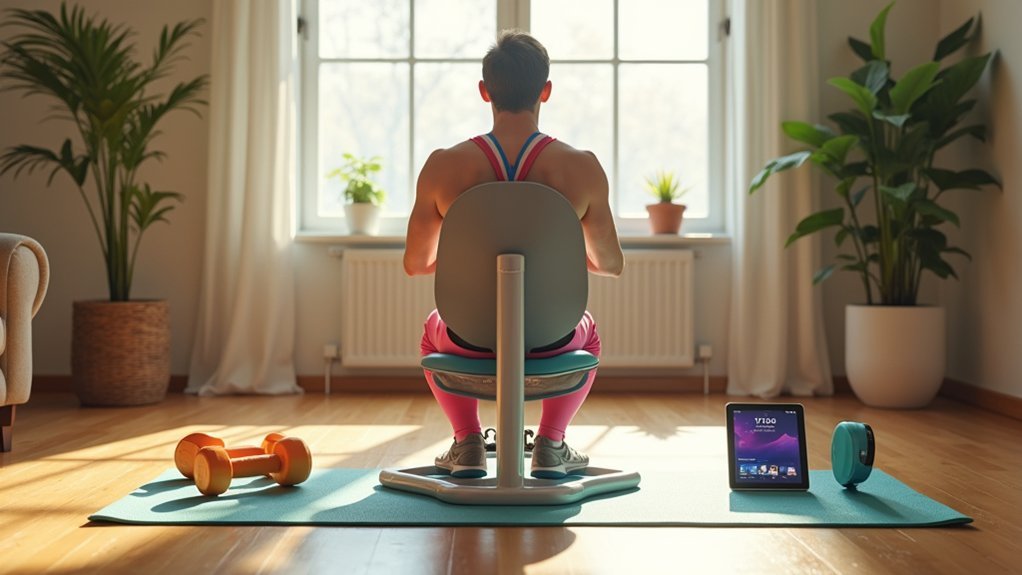You can achieve controller-free VR immersion by mastering precise hand positioning and gesture timing with systems like Oculus Quest, which delivers over 90% tracking accuracy. Focus on maintaining your hands within the sensor’s field of view while practicing grab-and-release mechanics, pointing gestures, and swiping motions. Keep movements deliberate to minimize detection errors from hand occlusion, and expect 20-millisecond response delays during interactions. Master these fundamentals to access advanced techniques that’ll revolutionize your virtual experiences.
Understanding Hand Tracking Technology in Virtual Reality
How can you control virtual objects with nothing more than the movement of your hands? Hand tracking technology in virtual reality makes this possible by using advanced sensors and machine learning algorithms to detect your hand positions and finger movements.
Systems like Leap Motion and Oculus Quest 2 capture your natural gestures, translating them into virtual interactions without physical controllers. This gesture recognition technology interprets various movements—pinching, dragging, and pushing—allowing you to manipulate objects intuitively in virtual environments.
The technology relies on fully articulated tracking systems that monitor your hands’ precise movements, enhancing immersion considerably.
Fully articulated hand tracking systems monitor precise finger movements, creating unprecedented immersion in virtual reality environments.
However, you’ll face challenges like detection errors during hand occlusion and the need to keep your hands within the sensors’ field of view for peak performance.
Comparing Camera-Based Hand Detection Systems
When you’re evaluating camera-based hand detection systems, you’ll find significant performance differences between platforms like Leap Motion and Oculus Quest’s built-in tracking.
Your experience with Leap Motion’s infrared scanning technology will likely differ from Oculus Quest’s computer vision approach, particularly in detection accuracy and response times.
You’ll notice these variations become most apparent when you’re performing precise gestures or rapid hand movements in virtual environments.
Leap Motion Performance Analysis
While camera-based hand tracking systems like Leap Motion offer intuitive, controller-free interaction, their real-world performance reveals significant gaps compared to traditional input methods.
When you’re using Leap Motion for hand gesture recognition, you’ll notice specific performance characteristics that affect your experience.
Your interaction patterns with Leap Motion typically involve:
- Longer grab times – You’ll spend more time initiating object selection compared to controllers.
- Shorter release times – Dropping objects happens faster once you begin the release motion.
- Fewer accidental drops – You’ll experience improved object retention versus basic implementations.
- Lower accuracy scores – Your precision suffers compared to traditional controller input.
Despite Leap Motion’s improvements in reducing unintended actions, you’ll find that detection errors and missing haptic feedback still limit its overall usability and speed compared to conventional controllers.
Oculus Quest Detection Accuracy
Since Meta released the Oculus Quest’s hand tracking feature, you’ve gained access to one of the most sophisticated camera-based detection systems available in consumer VR. The device’s detection accuracy consistently exceeds 90% under ideal lighting conditions, making controller-free hand tracking remarkably reliable for immersive experiences.
You’ll notice the system’s advanced machine learning algorithms precisely map your finger and hand movements in real-time. The combination of depth sensors and computer vision techniques effectively tracks your hand positions across varying orientations and movements.
With detection delays averaging just 20 milliseconds, you’ll experience improved responsiveness compared to traditional camera-based systems. The onboard processing power enables seamless gesture recognition integration with virtual objects, eliminating your need for external devices while maintaining exceptional tracking performance.
Direct Manipulation Techniques for Virtual Objects

You’ll need robust grab and place mechanics to create convincing virtual object interactions that feel natural and responsive.
These systems must accurately detect when you’re attempting to grasp an object and maintain that connection as you move your hand through 3D space.
Collision detection systems work alongside these mechanics to guarantee your virtual hands properly interact with object boundaries and surfaces.
Grab and Place Mechanics
Reaching out and grasping virtual objects transforms how you interact with digital environments, making the experience feel remarkably natural compared to traditional controller-based methods.
Through advanced hand tracking technology like the Leap Motion controller, you can perform grab and place actions by simply extending your hands toward digital items.
The gesture recognition system identifies specific hand poses that trigger object manipulation:
- Pinching motion – Thumb and index finger come together to grasp small objects
- Cupping gesture – Curved fingers wrap around larger virtual items
- Palm positioning – Open hand approaches objects before closing to grab
- Release motion – Fingers extend to drop objects at desired locations
While traditional controllers offer superior speed and accuracy, hand tracking considerably reduces accidental drops during object manipulation, creating more intuitive virtual experiences.
Collision Detection Systems
Two fundamental components work together to enable seamless virtual object manipulation: precise hand tracking and robust collision detection systems.
You’ll rely on bounding boxes or mesh colliders to determine when your hands interact with virtual objects, enabling accurate selection and grabbing actions in real-time. Technologies like Leap Motion provide the detailed input data necessary for tracking your hand gestures with precision.
Unity’s built-in physics engine simplifies implementing these collision detection systems, allowing you to define object properties and interaction rules intuitively.
You’ll enhance the experience by integrating haptic feedback, which simulates touch sensations when you interact with virtual objects. This combination creates convincing tactile experiences that make controller-free interaction feel natural and responsive.
Hand Beam Interaction Methods for Distance Control
When you need precise control over distant virtual objects without physical contact, hand beam interaction methods project an invisible line from your extended finger or hand, creating a natural pointing mechanism that feels intuitive and responsive.
Your gesture recognition system tracks hand position and orientation in real-time, ensuring fluid interactions as you interact with virtual objects. This hand beam technology proves especially valuable for users with mobility challenges or those unfamiliar with traditional controllers.
To maximize effectiveness, focus on these key techniques:
- Steady pointing – Maintain consistent finger extension toward your target object
- Clear activation gestures – Use deliberate pinching or trigger motions to confirm selections
- Smooth movements – Avoid jerky hand motions that confuse tracking systems
- Proper distance – Stay within ideal detection range for accurate beam projection
Future advancements promise enhanced detection range and improved precision for richer immersive experiences.
Gesture Recognition Patterns and Finger Positioning

As you refine your virtual reality interactions, gesture recognition patterns and finger positioning become the foundation for controller-free immersion.
You’ll need to configure hand pose recognition with specific shape recognizers that accurately detect hand orientation, swiping actions, and finger positioning for effective interaction.
Your swipe gestures require three critical conditions: precise pose detection, consistent hand movement, and monitored wrist rotation to trigger actions in virtual environments.
You can enhance gesture recognition by tracking finger positions using state thresholds for each finger, enabling intuitive object control.
Implementing active states within Unity detects hand gestures like pointing and swiping, ensuring responsive user experiences.
Visual feedback mechanisms, such as changing object colors upon gesture detection, greatly enhance your engagement by providing immediate, observable responses to your finger positioning and swiping actions.
Setting Up Pose Detection in Unity Development
You’ll need to integrate the Meta XR SDK into your Unity project before you can start building gesture recognition systems.
Configure your camera rig properly and set up the hand tracking blocks to guarantee your hand interactions display correctly in the scene.
Once you’ve established these foundational elements, you can begin setting up hand references for both left and right hands to enable extensive gesture detection.
Unity SDK Configuration
Setting up pose detection in Unity requires the Meta XR all-in-one SDK version 66 as your foundation for hand gesture recognition. This VR technology enables seamless hand tracking without controllers, transforming how users interact with virtual environments.
Configure your Unity project with these essential components:
- Scene Setup – Import the ‘large room’ prefab and apply ‘Skybox gradient’ material to create an immersive environment.
- Camera Configuration – Add camera rig and hand tracking blocks through Meta tools for proper tracking space.
- Gesture Framework – Implement ‘swipe forward gesture’ prefab with left and right hand references.
- Feature Providers – Include finger feature state and transform feature state providers for accurate detection.
You’ll establish activation states defining hand orientation conditions and swiping actions, ensuring your gesture recognition system responds precisely to user movements.
Hand Reference Setup
Once your Unity environment includes the essential tracking components, you’ll need to establish precise hand references for both left and right hands within your camera rig.
Search for and select the appropriate prefab, such as the ‘swipe forward gesture’ prefab, within the Unity editor to begin setup.
Configure hand references by adding necessary provider components including finger feature state, transform feature state, and joint delta provider.
These elements facilitate accurate hand movement detection and tracking throughout your virtual environment.
Set specific state thresholds for each finger within the finger feature state provider to enhance gesture recognition accuracy.
Verify you’ve correctly assigned all hand references to both hands, enabling seamless interaction and responsiveness.
This configuration establishes the foundation for reliable pose detection within your immersive experience.
Configuring Swipe Gestures and Movement Recognition
When implementing swipe gestures in Unity, you’ll need to establish hand references for both left and right hands while configuring essential provider components like finger feature state and joint delta provider.
This gesture recognition system monitors hand orientation and swiping actions through pose detection, hand movement, and wrist rotation to accurately trigger actions in your immersive VR environment.
Configure active states to detect specific conditions:
- Hand pointing detection – Monitor index finger position and orientation for gesture initiation
- Shape recognition – Identify open index finger configurations using the shape recognizer
- Movement tracking – Capture wrist rotation and directional hand movements for swipe actions
- Visual feedback integration – Create 3D objects that change properties to indicate detection areas
Duplicate forward swipe configurations and adjust parameters for backward swipes to prevent conflicts between gestures.
Optimizing Grab and Release Mechanics
While swipe gestures rely on continuous motion tracking, grab and release mechanics demand precise detection of hand states and finger positions to create intuitive object manipulation.
You’ll need to implement hovering gestures that require maintaining specific hand positions before initiating grabs, which increases grab times but reduces accidental drops considerably.
Camera-based hand tracking systems like Leap Motion excel at minimizing unintentional releases during object manipulation.
Camera-based hand tracking systems like Leap Motion excel at minimizing unintentional releases during object manipulation.
However, you’ll face challenges from missing haptic feedback, which can undermine your confidence during interactions.
To optimize your grab mechanics, focus on enhancing hand detection accuracy and reducing temporal offsets in video tracking.
These improvements create smoother user experience despite longer initial grab times, making the trade-off worthwhile for precise object manipulation.
Addressing Occlusion and Tracking Limitations
Even the most refined grab mechanics encounter significant obstacles when environmental factors interfere with hand detection. Occlusion becomes your primary adversary in controller-free environments, disrupting the seamless flow of hand gestures and breaking immersion when you need it most.
These tracking limitations manifest in predictable scenarios:
- Shadow interference – Your own body blocks camera sensors during natural movements.
- Hand-behind-back positioning – Reaching movements that break line-of-sight requirements.
- Temporal lag spikes – Video processing delays that disconnect gesture timing from visual feedback.
- Missing haptic confirmation – No tactile response leaves you guessing whether actions registered.
You’ll find yourself unconsciously adjusting your posture to maintain tracking, which feels unnatural and breaks immersion.
The key lies in anticipating these limitations and designing interactions that work within current technological constraints while pushing toward more robust detection systems.
Performance Metrics for Hand Tracking Accuracy
Although hand tracking technology continues advancing rapidly, measuring its real-world effectiveness requires precise performance metrics that capture both speed and accuracy during interactive tasks.
You’ll find that key metrics include total task completion time, grab time, release time, and accidental drop counts when evaluating hand tracking systems against your user’s hands movements.
Studies reveal that traditional Oculus Touch controllers still outperform hand tracking interfaces in both accuracy and speed.
However, advanced hand tracking systems like HHI_Leap show improvements over basic implementations, recording fewer accidental drops despite longer grab times. The hovering requirements greatly impact performance metrics.
Subjective usability ratings through System Usability Scale scores consistently show you’ll find traditional controllers more comfortable and intuitive than current hand tracking alternatives.
User Experience Design for Controller-Free Interfaces
As controller-free interfaces become mainstream, you’ll need to prioritize intuitive gesture recognition that reduces learning curves and enhances immersion for your users. Hand tracking technology offers particular advantages for demographics uncomfortable with traditional controllers, including older adults and children who benefit from natural movement patterns.
Natural gesture recognition eliminates learning barriers while providing intuitive interaction experiences that traditional controllers cannot match for all user demographics.
However, you’ll face significant design challenges that impact user experience:
- Hand occlusion detection errors that disrupt interaction flow
- Head orientation requirements forcing users to maintain specific positioning
- Temporal offsets in video-based tracking creating noticeable input delays
- Gesture recognition inconsistencies across different hand sizes and movements
The Leap Motion sensor’s customizable APIs enable you to tailor interactions for specific applications.
Remember that user feedback remains essential—studies show substantial differences in usability scores between hand tracking and traditional controllers, though advancing haptic feedback promises improved performance.
Future Advancements in Wireless Hand Tracking Systems
While current hand tracking systems face notable limitations, emerging wireless technologies promise to revolutionize gesture-based interactions within the next decade.
You’ll experience dramatically improved gesture recognition through advanced machine learning algorithms that’ll make your movements feel more natural and responsive. 5G integration will virtually eliminate latency, creating seamless real-time feedback that makes virtual reality interactions incredibly intuitive.
Enhanced optical and infrared sensors will enable reliable tracking across diverse lighting conditions, while compact wearable devices will boost your mobility and comfort.
You’ll also benefit from haptic feedback integration, where wireless hand tracking systems provide tactile sensations during virtual interactions.
These advancements will collectively transform how you navigate digital environments, creating unprecedented immersion levels in controller-free experiences.
Frequently Asked Questions
How to Use Your Hands in Meta Quest 3?
You’ll enable hand tracking in settings, then use natural gestures like pinching to select, grabbing to hold objects, and swiping to navigate menus. The headset recognizes your finger movements automatically for controller-free interaction.
How Does VR Finger Tracking Work?
VR finger tracking uses infrared sensors to scan your hand movements in real-time. Machine learning algorithms map your finger joints and positions, creating digital representations that let you naturally interact with virtual objects through gestures.
How Do Hand Controllers Assist in User Experience?
You’ll experience superior accuracy and speed with hand controllers compared to gesture tracking. They provide haptic feedback that enhances your tactile experience, reduce learning time, and offer more reliable interactions in virtual environments.
How Do I Temporarily Disable Hand Tracking in Quest 3?
You’ll navigate to your Quest 3’s device settings and select “Device,” then toggle hand tracking off. Alternatively, access the Oculus menu during VR sessions, go to “Settings,” and disable hand tracking there.
In Summary
You’ve now explored the essential components of controller-free VR interaction, from hand tracking fundamentals to advanced gesture recognition. You’ll need to evaluate your specific use case when choosing between camera-based systems and direct manipulation techniques. Don’t overlook occlusion challenges and performance requirements as you implement these technologies. By mastering these hand gesture principles, you’re positioning yourself to create truly immersive experiences that’ll define the future of virtual reality interaction.





Leave a Reply